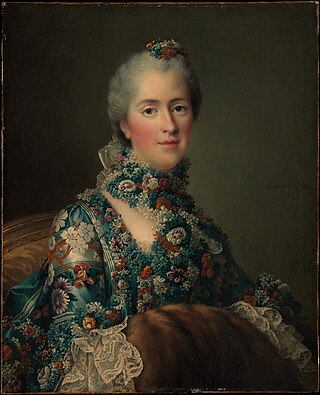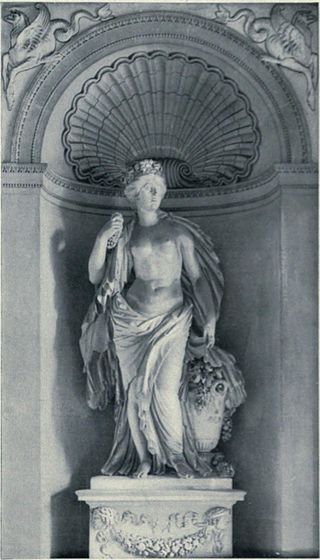Biography
His father was the sculptor, Augustin Pajou. Nothing is known of his childhood. In 1784, at the age of eighteen, he became a student at the Académie royale de peinture et de sculpture. Four attempts to win the Prix de Rome were unsuccessful.
In 1792, he became a member of the Compagnie des arts de Paris, organized by the Louvre, alongside the painter Louis-François Lejeune as well as the future economist, Jean-Baptiste Say. While stationed with the regular army in Sedan, he wrote numerous letters to his friend, François Gérard. which express his initial enthusiasm, but gradually turn to boredom, disillusionment and physical exhaustion.
After being demobilized, he participated in creating the "Commune générale des arts", an institution designed to replace the Académie Royale. He served as Secretary for the Commune's President, Joseph-Marie Vien. In 1795, he married Marie-Marguerite Thibault (1764-1827). Under the First Empire, he was commissioned to paint a portrait of Maréchal Louis-Alexandre Berthier, which may still be seen at Versailles. In 1812, he was awarded a gold medal for his depiction of Napoleon offering clemency to the Royalists who had taken refuge in Spain.
In 1811, at the urging of François-Guillaume Ménageot, who had become apprised of the precarious financial situation facing the sculptor David d'Angers, Pajou wrote a letter to the mayor of Angers, demanding that material aid be given to the sculptor. The aid was granted and was considered a lifesaver for d'Angers, who went on to win the Prix de Rome for sculpture and spend several years at the French Academy in Rome. In 1814, he painted three tableaux celebrating the Bourbon Restoration. They were displayed at the Salon and it is possible they were seen by Napoleon.
He resigned from most of the associations of which he was a member in 1823, citing poor health. In a letter from that period, he says that he was "cruelly tormented for a year by a continual tremor." He died in 1828 and was interred at the Cimetière du Père-Lachaise.
His son, Augustin-Désiré Pajou [ fr ] also became a well-known painter.

The Prix de Rome or Grand Prix de Rome was a French scholarship for arts students, initially for painters and sculptors, that was established in 1663 during the reign of Louis XIV of France. Winners were awarded a bursary that allowed them to stay in Rome for three to five years at the expense of the state. The prize was extended to architecture in 1720, music in 1803 and engraving in 1804. The prestigious award was abolished in 1968 by André Malraux, then Minister of Culture, following the May 68 riots that called for cultural change.

Augustin Pajou was a French sculptor, born in Paris. At eighteen he won the Prix de Rome, and at thirty exhibited his Pluton tenant Cerbère enchaîné.

Anne-Louis Girodet de Roussy-Trioson, also known as Anne-Louis Girodet-Trioson or simply Girodet, was a French painter and pupil of Jacques-Louis David, who participated in the early Romantic movement by including elements of eroticism in his paintings. Girodet is remembered for his precise and clear style and for his paintings of members of the Napoleonic family.

Pierre Mignard or Pierre Mignard I, called "Mignard le Romain" to distinguish him from his brother Nicolas Mignard, was a French painter known for his religious and mythological scenes and portraits. He was a near-contemporary of the Premier Peintre du Roi Charles Le Brun with whom he engaged in a bitter, life-long rivalry.

Baron François Joseph Bosio was a Monegasque sculptor who achieved distinction in the first quarter of the nineteenth century with his work for Napoleon and for the restored French monarchy.

Pierre-Jean David was a French sculptor, medalist and active freemason. He adopted the name David d'Angers, following his entry into the studio of the painter Jacques-Louis David in 1809 as a way of both expressing his patrimony and distinguishing himself from the master painter.

François Pascal Simon Gérard, titled as Baron Gérard in 1809, was a prominent French painter. He was born in Rome, where his father occupied a post in the house of the French ambassador, and his mother was Italian. After he was made a baron of the Empire in 1809 by Emperor Napoleon, he was known formally as Baron Gérard.

Jean-Baptiste Jacques Augustin was a French miniature painter.

Louis-Simon Boizot (1743–1809) was a French sculptor whose models for biscuit figures for Sèvres porcelain are better-known than his large-scale sculptures.

François-Hubert Drouais was a leading French portrait painter during the latter years of Louis XV's reign. His clientele included the French royal family and nobility, foreign aristocracy, fermiers-généraux, and the wealthier members of Parisian society and their favourites. But it was his increasing popularity at the French court that expanded his clientele and made his portraits a fashionable necessity. Drouais's work was admired during his lifetime, and his popularity and clientele did not diminish from the occasional adverse judgement published in Salon reviews.

Charles de Wailly was a French architect and urbanist, and furniture designer, one of the principals in the Neoclassical revival of the Antique. His major work was the Théâtre de l'Odéon for the Comédie-Française (1779–82). In his designs, de Wailly showed a predilection for the perfect figure, the circle.

Nicolas-André Monsiau was a French history painter and a refined draughtsman who turned to book illustration to supplement his income when the French Revolution disrupted patronage. His Poussiniste drawing style and coloring marked his conservative art in the age of Neoclassicism.

Louis Candide Boulanger was a French Romantic painter, pastellist, lithographer and a poet, known for his religious and allegorical subjects, portraits, genre scenes.

Jean-Joseph Foucou was a French sculptor.

Jean-Baptiste Marie Pierre was a French painter, draughtsman and administrator.

Pierre-Jacques Cazes was a French painter who specialized in religious and mythological subjects. He also taught several other French artists including François Boucher and Jean-Siméon Chardin.

Jacques-Henri Sablet was a Swiss-French painter, part of a family of artists of Swiss origin. He was also known as Franz der Römer, Giacomo Sablez, Giacomo Sablé, Jacob Henry Sablet, Sablet le Jeune, Sablet le Romain or le peintre du Soleil.

François Dumont was a French sculptor.
Jean-Baptiste Cyprien d'Huez was a French sculptor.
The French Restoration style was predominantly Neoclassicism, though it also showed the beginnings of Romanticism in music and literature. The term describes the arts, architecture, and decorative arts of the Bourbon Restoration period (1814–1830), during the reign of Louis XVIII and Charles X from the fall of Napoleon to the July Revolution of 1830 and the beginning of the reign of Louis-Philippe.



















